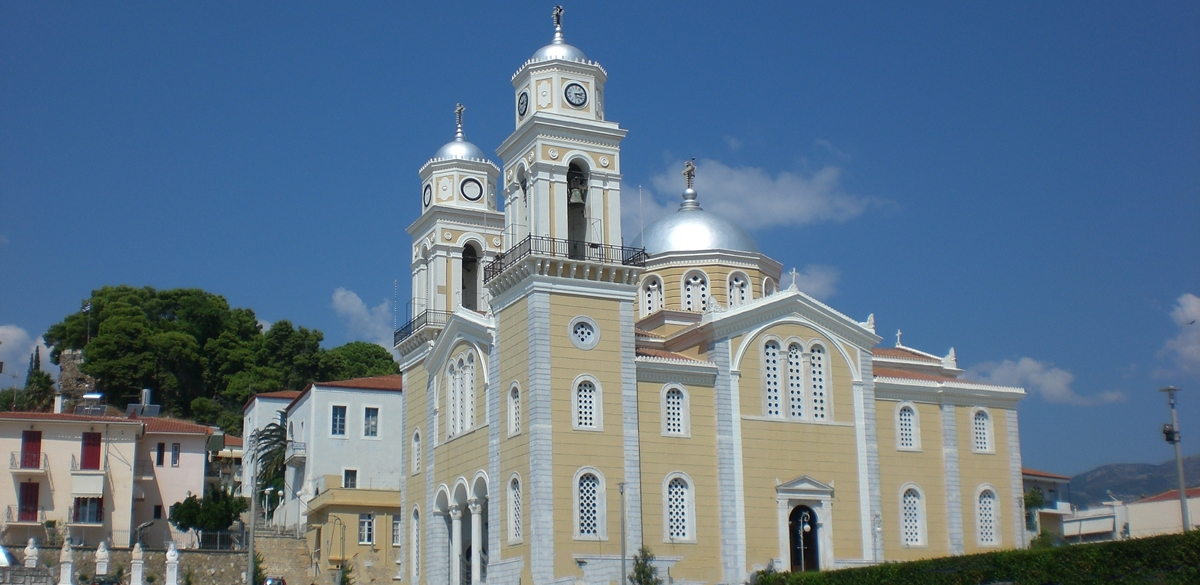KALAMATA CHURCHES

PLEASE NOTE THAT ALL THE PHOTOGRAPHS ON THE SITE ARE CLICKABLE LINKS

PLEASE NOTE THAT ALL THE PHOTOGRAPHS ON THE SITE ARE CLICKABLE LINKS
The Church of Ypapanti in the square with the same name is the Metropolitan Cathedral of Kalamata. It was founded in 1860 and inaugurated in 1873 very close to the location of the old church that was there until 1770 when it was burnt.
According to the legend the icon of the church was found in the ruins of the temple that was destroyed in 1770, when the groom of the Turkish Pasha had a stable there for his horses. He had a dream and in it he saw a woman telling him to dig in the stable to find the icon. Which he did.
This is why there is a stone cross to the southeast of the Church of Ypapanti at the point where it is considered to be the original altar with the inscription: "this plaque is reminiscent of sacred and sanctum".
The church belongs to the cruciform type with a dome and large narthex with two bell towers. It was severely damaged by earthquakes in 1886 and 1986 but was restored twice.
Agioi Apostoloi is a Byzantine church, built in 1317 by the Emperor Andronikos in March 23 Square in the centre of Kalamata.
On Wednesday, March 23 1821, Theodoros Kolokotronis, together with the other leaders and Greek warriors liberated Kalamata from the Turks and assembled with the population and the clergy in the square of Agio Apostoloi, where the first Christian mass was said on free Greek territory after 400 years of slavery. In this church the Greeks took an oath of loyalty to the revolution.
The church actually consists of two temples built five centuries apart as the two domes show. The first one in the eastern part of the church with free cross style was built in the late 11th to early 12th century and the second one with cross single room dome dates back to the Venetian rule of the late 17th to early 18th century.
In the oldest part of Agioi Apostoloi are frescoes dating back to the 16th and 17th century, which have been preserved despite the extensive damage due to the earthquake in 1986.
Agioi Apostoloi suffered considerable damage twice in its history: in 1884 when part of the bell tower collapsed because of an earthquake and in 1892 when the Byzantine frescoes were covered with lime. After the earthquake in 1986 the church was restored back to its original form.
Agios Nicolaos Flarios is located in the center of Kalamata. It is believed that it was founded in 1859 and its inauguration was in 1865. According to historians, the church was founded on the ruins of the older church of Agios Nicolaos Xenon.
The church has been deemed a building requiring special protection, it is a cross-shaped construction and a wonderful example of neoclassical architecture from the second half of the 19th century. As mentioned in the General State Archives the marble of Agios Nicolaos Flarios was brought from the island of Tinos.
The Catholic Monastery of Kalograion is a vital part of the history of Kalamata and Messenia since for more than 200 years it had been a spiritual refuge for many young girls who chose the monastic life, and a warm and benevolent home to many orphans and abandoned children, especially after the German Occupation of Greece.
After the earthquake of 1986 the nuns of the Monastery prepared food in the monastery's yard for over a year for hundreds of the city's inhabitants who had lost their homes.
The nuns are still active in the production of silk products, which gave both the nunnery, and Kalamata as a town, a reputation in the past.
A walk through the peaceful courtyard and a look into some of the ground floor rooms reveals the looms still used to weave silk. Many items made in silk by the nuns are available in the shop of the monastery.
The Monastery maintains a treasury and museum where many Holy Relics of various Saints are kept, along with vessels, vestments, precious Icons and part of the old Templon, while its rich library contains many theological and other books.
In the 6th century AD a church was built in the castle devoted to the Virgin Mary. An icon of Virgin Mary in the church became famous as 'Kalomata' (meaning 'beautiful eyes'). This later changed to 'Kalamata' which became the name of the church, the castle and the city.
There are many more churches in Kalamata but I have yet to get round them all!!
The photographs below are more of the Kalograion Monastery.